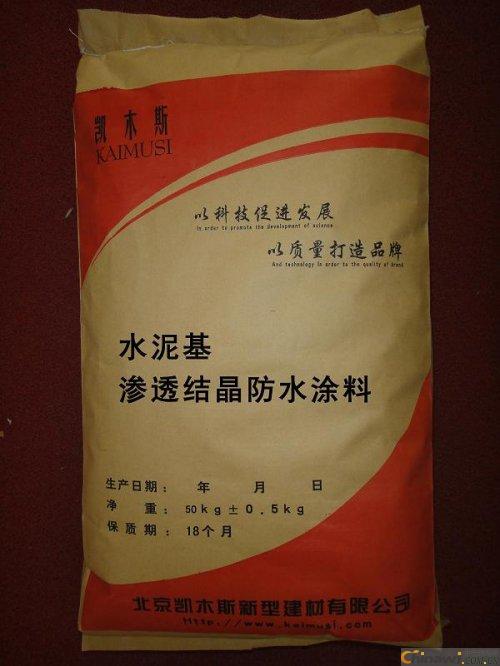Mechanism of Action of Cement-Based Permeable Crystalline Waterproof Coating
     Cement-based permeable crystalline waterproof coatings are a type of advanced rigid waterproof material made from Portland cement, quartz sand, and active chemical compounds. Unlike traditional waterproof coatings that rely solely on surface films, these coatings penetrate into the concrete substrate to form crystals that seal pores and capillaries. This creates a durable waterproof layer with some flexibility, allowing it to cover fine cracks and resist minor vibrations.
1. Mechanism of Action of Cement-Based Permeable Crystalline Waterproof Coating
Different types of cement-based permeable crystalline waterproof coatings contain various active ingredients, but all follow a similar process: dissolution, penetration, and crystallization.
1.1 Dissolution Process
The active components dissolve in water to form small molecules, which then polymerize and grow under specific conditions to create water-insoluble crystals. In dry conditions, the coating is not reactive, but when exposed to moisture, the active substances begin to react, forming crystals that block the internal structure of the concrete.
1.2 Penetration Process
When applied to the concrete surface, the active materials create a high-concentration area on the surface while the interior has lower concentrations. If the concrete is saturated with water, the concentration gradient drives the active ions to penetrate into the pores. This process requires the concrete to be sufficiently wetted during application for optimal performance.
1.3 Crystallization Process
Crystallization occurs through precipitation reactions or complexation-precipitation reactions.
1.3.1 Precipitation Reaction Crystallization Mechanism
Concrete contains free lime (Ca²âº) and calcium hydroxide (Ca(OH)â‚‚). When the active components penetrate into the pores, they chemically react with these substances to form insoluble crystals that seal the capillary network, preventing water ingress. This significantly improves the waterproofing capability of the concrete.
1.3.2 Complexation-Precipitation Reaction Crystallization Mechanism
In areas rich in Ca(OH)â‚‚, the active components form a soluble calcium complex. As this complex diffuses through the concrete pores, it reacts with unreacted cement or cement gel, leading to the formation of stable silicates or aluminates, resulting in crystal growth and pore sealing.
2. Application of Osmotic Crystalline Waterproof Coating
With increasing demands for concrete durability, its permeability plays a key role in long-term performance. Osmotic crystalline waterproof coatings help reduce permeability by sealing internal pores and micro-cracks, thereby improving the overall durability of the structure.
2.1 Mechanism of Action
Once applied, the coating penetrates into the concrete, reacting with its components to form crystals that seal the pores. This creates a protective layer within the concrete, enhancing its resistance to water and improving long-term performance.
2.2 Waterproof Principle
The coating uses the porosity of concrete as a pathway. Water carries the active ingredients into the pores, where they react with ions in the concrete to form insoluble crystals. These crystals expand and fill the pores, creating a dense, impermeable layer that significantly reduces water penetration.
2.3 Characteristics of Osmotic Crystalline Waterproof Coating
(1) Resists high hydrostatic pressure due to deep penetration of crystals. (2) Requires wet construction areas; dry concrete must be pre-wetted before application. (3) Provides two-way waterproofing by integrating with the substrate. (4) Offers good wear resistance after drying, suitable for pedestrian areas. (5) Flexible enough to cover cracks up to 0.4mm in width. (6) Compatible with tiles, plasters, and paints after drying. (7) Non-toxic, safe for use in drinking water tanks and fish ponds. (8) Maintains gas permeability while blocking water, allowing proper curing and drying of concrete. (9) Available in different colors for easy identification and aesthetic purposes.
3. Construction of Osmotic Crystalline Waterproof Coating
3.1 Basic Requirements and Surface Preparation
(1) Ensure the surface is clean, flat, and free of debris. (2) Fill small holes with a wet cement paste for smoothness. (3) Round sharp corners with cement mortar for better adhesion. (4) Apply the coating on a properly bonded and thick concrete base. (5) Wet the surface before application, but avoid standing water.
3.2 Application Methods
(1) Use a brush or sprayer to evenly wet the surface without excess water. (2) Mix the concentrated paint with water to form a thick paste, stirring thoroughly to avoid lumps. (3) Apply the mixture in one direction, ensuring even coverage and filling all pores. (4) Apply the second coat after the first is partially dry, ensuring strong adhesion between layers. (5) Brush the second coat perpendicular to the first for full coverage and allow 24 hours for drying before proceeding. (6) Avoid high temperatures and rain during application to prevent premature drying and cracking.
Conclusion:
(1) The osmotic crystalline waterproof coating seals pores through crystal growth, while also promoting cement hydration to increase density and improve waterproofing performance. (2) Concrete permeability is influenced by both external factors like water pressure and internal defects. The coating enhances impermeability and extends the service life of the structure.

Steel Ball For Bearing,Carbon Steel Ball For Bearing,Ball Bearing,Stainless Steel Half Ball
NINGBO YWC IMP. & EXP. CO.,LTD , https://www.nbywc-fastener.com